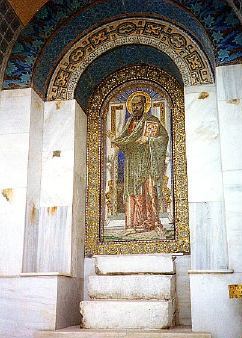| On the way to Beroea, where Paul fled when he left Thessalonica, the guide surprised us with a stop at Vergina to see the bones of Philip and other members of his royal family. Excavations in this area, conducted for over a century, have uncovered a palace, pagan temples and other finds, but the unplundered royal tombs were discovered only in 1977. King Philip of Macedonia, 359 - 336 b.c.e., took his barbaric little country of peasants without a seaport, created a powerful military force and brought Greece into a single confederacy in 338 b.c.e. Before Philip, even during the Golden Age of Socrates, Plato and Aristotle, Greece was not a nation but a geographic area of tribes and city states. Unfortunately, at the height of his power, Philip was assassinated by one of his bodyguards during the marriage of his daughter. So, in 336, at the age of 20, Alexander, specially educated by his father for empire, was crowned King of Macedonia to fulfill Philip's dream of conquest of Persia and the unification of the known world into a single Hellenistic empire. |  |



